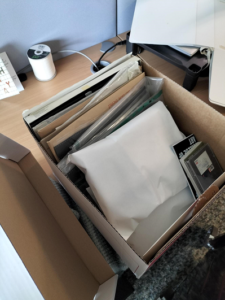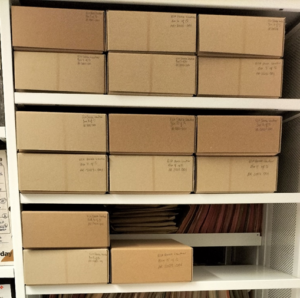My name is Jasmine, and I’ve been working here at the University for five and a bit months as the Collections Management Technician. I’m the other half to Robyn Rogers’ role as Collections Care Technician, whose fantastic blog post about her recent work you can read here, and I work directly with the Appraisal Archivist and Archives Collection Manager, Abigail Hartley, whose equally wonderful blog post was featured last month.
Abigail did a great job of defining appraisal and the challenges to the archivist when it comes to choosing what material to preserve. The archivist is often put in the position of assessing the ‘value’ of the record, a thorny process which comes with a number of ethical challenges. Thinking through these problems, it might seem easier to suggest that we simply keep everything we receive. If we get to keep everything, we don’t have to think through complicated questions, like what is the purpose of the record? And what is the purpose of the archivist? After all, if something has found its way into the archive, isn’t that an implicit statement of its value? Why appraise at all?

The process of sorting through material in boxes to first determine what is inside them is the first stage in the appraisal process
An important part of the role of the Conservation and Collections Management team is making collections accessible to researchers. Having tens, or even hundreds of copies of the same record makes life more difficult for cataloguing staff who must list the material, for reading room staff who must retrieve the material, and for researchers who must select, request and interpret that material. But accessibility to researchers is not the only issue if we leave records unappraised. Unfortunately for us, archives are real, tangible spaces with limited amounts of physical room. If records aren’t appraised, we run the risk of running out of space for collections very quickly. Even a digital archive which may appear to have an infinite amount of space is usually hosted on servers, which cost money and can have a significant environmental impact.
Because we are dealing with paper records, in a physical building which does have limited space to house its collections, it’s crucial that we do appraise our records. Doing so ensures that we have enough physical room to safely and securely house all our existing material and continue to expand and develop our archive holdings so that we can support learning, teaching and research. Mapping our existing spaces and finding areas where we can shuffle or rehouse collections to free up more room has been another part of my role. The appraisal work Abigail and I are undertaking will hopefully allow us to increase the free space we have available.
Appraisal aside, space management can be a complicated affair. We have to work together across teams to ensure all the right people are aware of archives arriving into our stores, identify space for it to be housed, and ensure the space is suitable for the material by making sure shelving is pitched at the correct height and appropriate preservation measures are in place. Sometimes it can feel a bit like playing Tetris.

Space management is much easier when all your collections are housed in neat, standard sized boxes, with all the shelves pitched at a standard height, but archives rarely arrive in beautiful acid free standard sized boxes. Sometimes our archives contain objects, like clocks or even chairs, which can’t be housed in a predictable nicely stackable container. Often, archives arrive in large boxes like bankers boxes which take up more space and aren’t suitable for the material’s long-term preservation. Looking at our collections and seeing where we could rehouse materials has been another part of my role, one which I’ve shared with our Collections Care Technician. Space management isn’t all appraisal work – sometimes a simple re-boxing can save a surprising amount of space.
Appraising collections and managing space in the stores can feel like an overwhelming task in an institution with such vast holdings, and there are lots of tough questions to answer, but the work is incredibly rewarding. Turning an unwieldy bankers box full of loose papers into a manageable archive box which we know contains material researchers can use is gratifying work, and it’s great to be part of the chain of hardworking staff who turn the records we receive into material researchers can use.

Pingback: Lingerie, Giant Frisbees and Heavy Lifting: Tackling the ITI Collection at Edinburgh University | Preservation Perspectives